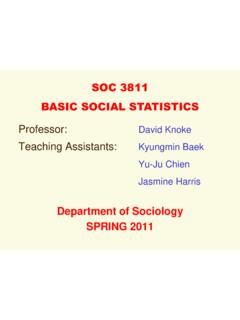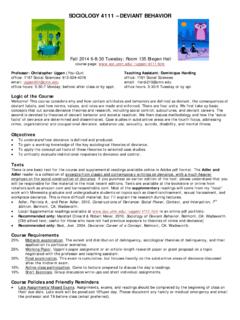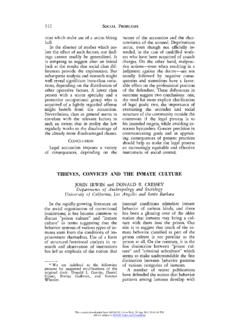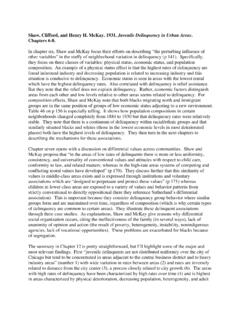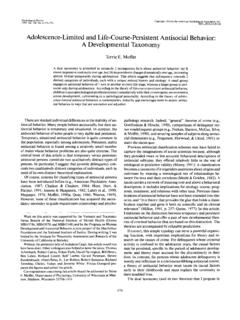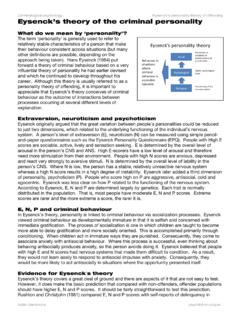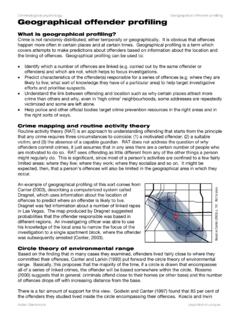Transcription of Criminology, Gender, and Race
1 Feminist Criminology2016, Vol. 11(4) 311 333 The Author(s) 2016 Reprints and DOI: Issue: Is Criminology Still Male Dominated?Criminology, Gender, and Race: A Case Study of Privilege in the AcademyMeda Chesney-Lind1 and Nicholas Chagnon1 AbstractCriminology has historically exhibited a significant gender bias. Yet, spurred by feminist efforts, criminology has become more gender-inclusive recently. Research has documented this bias, and gains made by women. However, much of this research examines only gender bias, ignoring other important factors such as race. In this article, we examine gender and racial bias in criminology, conceptualizing the discipline as a Bourdieusian field, characterized by hierarchically arranged positions.
2 We find that though women are present in nearly equal numbers to men, non-White people have a more limited presence, and White men dominate in positions endowed with the highest amounts of prestige and of criminology, intersections of race/class/gender, race, women, women as criminologistsIntroductionFeminist criminologists have long criticized the masculinist bias in criminology, argu-ing for the inclusion of women, women s insights, and the study of women in the field. This bias has generally been manifest in two interrelated phenomena the ways in which criminologists have ignored women s experiences with crime and justice, and the limited presence of female criminologists in the field.
3 Some studies have documented significant gains made by women in gaining access to the field and promoting feminist insights in research agendas (Baro & Eigenberg, 1993; Eigenberg & Baro, 1992; Love & Park, 2013; Sharp & Hefley, 2007). On the contrary, the same 1 University of Hawaii at Manoa, Honolulu, USAC orresponding Author:Nicholas Chagnon, University of Hawaii at Manoa, 2424 Maile Way, Honolulu, HI 96822, USA. Email: CriminologyChesney-Lind and Chagnonresearch-article2016 at UNIV OF MINNESOTA on September 8, from 312 Feminist Criminology 11(4) research has found that these gains are often quite limited. For example, while women are now regularly included in samples of criminological studies, the analysis of gender in such studies is often superficial at best (Sharp & Hefley, 2007).
4 As much research on the topic is nearing two decades old, this study makes a new attempt to investigate masculinist bias in criminology, as well as add the issue of racism to this discussion. Specifically, we employ an analysis inspired by Bourdieu s (1984) work on the field, to map the gendered and racialized landscape of the criminological academy course, criminology is not alone in having legacies of sexism and racism. A plethora of prestigious professional and academic fields have historically exhibited sexism and racism. However, scholars have noted that, today, although there is often a high level of concern about increasing cultural and gender diversity in fields such as science, technology, engineering, and mathematics (STEM), there is often far less interest in seeking to increase this in the social sciences (Jenkins, 2014).
5 Our article begins with a discussion of some key ways that women and non-White criminologists and their contributions have been historically marginalized. We then critically review the contemporary status of female and non-White scholars in the field while consider-ing how the emerging logic of the neoliberal academy, with its emphasis on perfor-mance, efficiency, mobility, competitiveness and evaluation (Jenkins, 2014, p. 161), functions to suppress culturally diverse scholarship (Ishikawa, 2014). To do so, we conceptualize criminology as a Bourdieusian field, comprised of hierarchically arranged positions, endowed with differential amounts of capital.
6 Our study will examine who occupies several key positions in the field, focusing on the gender and racial makeup of those populations, and we will consider our findings in light of the contemporary neoliberal context that arguably marginalizes diverse viewpoints within the criminological theory : A Problematic LegacyA brief survey of American criminology illustrates the analytical bias that has been present in the discipline since its advent. Prior to the mid-1970s, theorizing about crime and delinquency was actually theorizing about male crime and delinquency, although the myopic theoretical and research focus on males was largely seen as unproblematic or even easily defensible.
7 As well, considerations of race were bypassed, as class became the main theoretical focus. The study of urban gangs in cities like Chicago, their subcultures, and their structures is a core part of this legacy (Hagedorn & Chesney-Lind, 2014); these gangs were assumed to be male, and their public dis-plays of male aggression and violence perfectly fit a field that focused on public crime and victimization, and the use of official rapid urbanization and industrialization happening in cities like Chicago at the turn of the century came along with extreme, highly visible inequality. The out-rageously affluent lived in opulence alongside the enormously unfortunate trapped in squalor.
8 Early American criminologists saw in such a milieu an opportunity for using positivist criminology to illuminate and explore the dimensions of social problems. In opposition to the nativism of many contemporary political leaders, these criminologists at UNIV OF MINNESOTA on September 8, from Chesney-Lind and Chagnon 313rejected the idea that race or ethnicity was a prime criminogenic factor. Instead, they documented how patterns of delinquency clustered and persisted in poor neighbor-hoods, for longer than any individual ethnic group occupied the area (Park, Burgess, McKenzie, & Wirth, 1925). However, such research entailed an exclusive analysis of public male Delinquency in Urban Areas (Shaw & McKay, 1972) serves as a classic example of this selective analytical vision.
9 The study referred to delinquency rates based only on the measurement of male misbehavior simply as delinquency rates, though female rates were parenthetically acknowledged at times. The Jack-Roller (Shaw, 1931) and Brothers in Crime (Shaw, McKay, McDonald, Hanson, & Shaw, 1938) are other examples of classic studies examining only male deviance. Moreover, in his seminal work on group delinquency, The Gang, Thrasher (1927) nearly left out female gangs entirely, save for approximately a handful of pages out of about Chicago school did produce some important contributions that remain relevant today, including a focus on subcultures, social disorganization, and the criminogenic consequences of class and inequality.
10 Furthermore, subsequent researchers built upon the idea that juveniles sense of masculinity was a key element in delinquent behavior (Cloward & Ohlin, 1966; Cohen, 1955). However, these delinquency theories entailed significant blind spots in relation to the consequences of male violence, including the fact that their victims were often the women around them, not just other men. Moreover, the Chicago School s lack of interest in gender is noteworthy given it, rather than class, has a dramatic effect on levels of criminality (Daly & Chesney-Lind, 1988; Leonard, 1981). Finally, by conflating ethnicity and race, and ignoring the legacy of slavery in American culture, the Chicago school set up criminology to miss what emerged as the major feature of the functioning of the criminal justice system (CJS) a system that over-policed and over-punished African Americans for minor deportment and drug offenses (Chesney-Lind & Chagnon, 2015)These same blind spots continually appear in more contemporary delinquency and crime theories, for example, strain theory , differential association, lower class focal concerns, labeling, and Marxist theories of crime.
